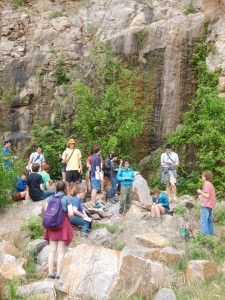Learning the Land: A Professional Opinion
Marcia Bjornerud is a Professor of Geology and the Walter Shober Professor of Environmental Studies at Lawrence University in Appleton. She has been with the university since 1995, and has traveled the world studying geology. She gives us her views on geology in the Fox Cities area.
First off, give me a little background on your past as a geologist, a brief overview of your research and interests, and what brought you to the area.

Bjornerud teaching a class at an abandoned quarry near Baraboo, WI, now a State Natural Area. Photo credit: Paul Eggen.
When I started college, I really didn’t know anything about geology, like most people don’t. It’s not represented in high school curricula in the same way other sciences are. So, like many people who find their way into geology, I started by taking a class because I had to take a science class, and then once I did, I was sort of hooked. So, I had considered myself more of a humanities-type person, and when I took Intro Geology and went out and saw its huge explanatory power, I think that was what converted me. And my interest had always been, actually, in linguistics and language evolution, and I think there are some parallels. Geology, for me, when you really understand the deep history of a place, it’s almost like the etymology of a word. It might be a very familiar word that you use in everyday life, but then when you see what its origins are, deep in human history, suddenly it’s like this new vision. And for me, it’s very much the same with geology. You can have a landscape that you drive by all the time, but when you understand the geologic origins of it, a window goes up, and suddenly it’s transformed; there’s a deep sense of connectedness to the past. So, for me, geology is satisfying. It has very practical applications, but there are also, kind of, philosophical or even spiritual elements to the field. My own area is structural geology. It has to do with tectonics, mountain-building, earthquakes. And people think, well, we don’t have any of those things in Wisconsin. But actually, especially the northern part of the state has a record of pretty much every type of tectonic setting that we can see on earth today. Ranging from places like the cascades where we have volcanoes and big earthquakes, to places like Yellowstone where we have a lot of magmatic activity and volcanism, and even places like Iceland; we once were on the middle of a big rift zone. So we have pretty much every type of tectonic setting represented in the old bedrock of the northern part of the state. So this is actually a good place to practice structural geology. Great place to teach it. I can take students out, not too far afield, and see examples.
What intrigues you most about the geology of the Fox Cities region?
Well, it’s surprisingly complicated. The rocks right here in the Fox Cities are mostly ancient marine sedimentary rocks, so they haven’t been disturbed too much by the tectonic story that I was just talking about, but deep underneath them are these much older rocks. But we also have this really rich glacial story. This region of Eastern Wisconsin is actually world-renowned for glacial features. People come from far and wide to the Kettle Moraine area, to the Door County area, to see glacial features that we have. And, from a practical standpoint, it’s just really important to understand the geology. It effects groundwater, it effects resources. Every place has an interesting story, and we have many layers.
How have some of these geological processes effected the industry and our way of life in the region?
The river is really the heart of it all, and the river has roots, really, in the glacial story. There probably was some older version of the Fox River, before the last glacial maximum, but the Fox as we know it today has been carved really in the last 10,000 years. And it’s linked with the changing geometry, especially Lake Michigan as well, which is a glacial feature. So we have the modern river and the landscape around the river. Stone, especially the Silurian dolomite of the escarpment, has always been an important building stone. Many of the buildings on the Lawrence campus and elsewhere in the Fox Cities region are Silurian dolomite, locally quarried. People are probably familiar with fracking. More recently, frac sand has become a valuable commodity. It’s a little bit less in demand than it was a couple of years ago, but it’s probably going to come back. And that’s coming out of Cambrian beach sand that’s exposed a little bit west of the Fox Cities. And many of the places that people love best, just because of the landscapes and the natural settings, are really geological in origin. So the Door Peninsula exists because of the geology. The lakes are, again, a legacy largely of the glacial period. So the places that people go to, the state parks and the county parks that we all love, are legacies of geology.










Leave a Comment